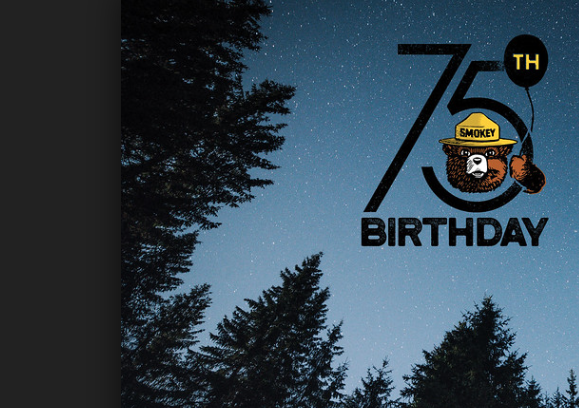One of the most recognized icons and the star of the longest-running public awareness ad campaign in US history celebrates 7½ decades of advocating for campfire safety and wildfire prevention this week. Smokey Bear, born on Aug. 9, 1944, turns 75-years-old today.
Smokey Bear was born out of a collaboration between the U.S. Forest Service and the Ad Council to promote forest fire prevention and reduce the number of human-caused accidental fires. The first images of Smokey Bear were of the conservation-minded ursine extinguishing a campfire with a bucket of water. Incorporating Smokey Bear’s image on numerous forest fire prevention materials in the following years further popularized the mascot. In 1947, Smokey Bear began using his now-familiar slogan: “Only YOU can prevent forest fires.”
But in spite of Smokey Bear’s widespread recognition in the US and even abroad, the work to reduce human-caused, unplanned forest fires must be sustained. Human activity continues to be the primary cause of wildfires; an overwhelming majority of US forest fires – 89%– are started accidentally or intentionally by people.
And though the work to promote campfire safety and wildfire prevention has carried on throughout the decades, Smokey Bear’s attitude about certain types of forest fires has evolved to reflect new science and information. Smokey Bear’s messaging has become more nuanced as research confirms that some fires can be beneficial.
As a recent National Geographic article recently articulated:
“Although often harmful and destructive to humans, naturally occurring wildfires play an integral role in nature. They return nutrients to the soil by burning dead or decaying matter. They also act as a disinfectant, removing disease-ridden plants and harmful insects from a forest ecosystem. And by burning through thick canopies and brushy undergrowth, wildfires allow sunlight to reach the forest floor, enabling a new generation of seedlings to grow.”
Instead of an all-out ban on forest fires practiced throughout the first half of the 20thcentury, the Smokey Bear messaging of today resembles the sustainable forestry and active management methods that working forests and private timberland owners adhere to in order to reduce catastrophic wildfire. Selective harvests, thinning treatments and brush removal help prevent overcrowding and an over-accumulation of fuel. Prescribed fires help clear out vegetation, dispose of excess wood debris on the forest floor and prepare new seedbeds for future trees.
According to Smokey Bear’s website:
“When fires burn in intervals appropriate to their ecosystem, they consume leaf litter and other ground vegetation like dead wood. This can trigger a rebirth of forests, helping to maintain native plant species. Ecosystems that are dependent on fire to thin the forest canopy and cultivate the forest are slowly transformed without enough natural fire. Sunlight-dependent native plant species are overtaken by those that like shade, and the whole ecosystem becomes less diverse, more dense from undergrowth, and littered with dead plant material. Fire managers can reintroduce fire into fire-dependent ecosystems with prescribed fire…the beneficial effects of natural fire can be recreated, fuel buildup can be reduced, and we can prevent the catastrophic losses of uncontrolled, unwanted wildfire.”
In honor of Smokey Bear’s more than seven decades of public service, organizations have scheduled several birthday events throughout the state and the US. Upcoming Smokey Bear celebrations include parties in:
- Chewelah at the Colville National Forest
- Entiat at the Columbia Breaks Fire Interpretive Center
- Vancouver at Gifford Pinchot National Forest
- Seattle at Filson
The free, family-friendly events include opportunities to meet Smokey Bear and wish him a happy birthday in person. The Smokey Bear birthday parties also will include wildfire prevention tips, Smokey Bear-themed party favors and other fun activities. Learn more about Smokey Bear’s history, wildfire prevention and the important role of wildland fires here.
To learn more about working forests and the science-driven methods private forestland owners use to prevent and reduce catastrophic wildfire, click here.
